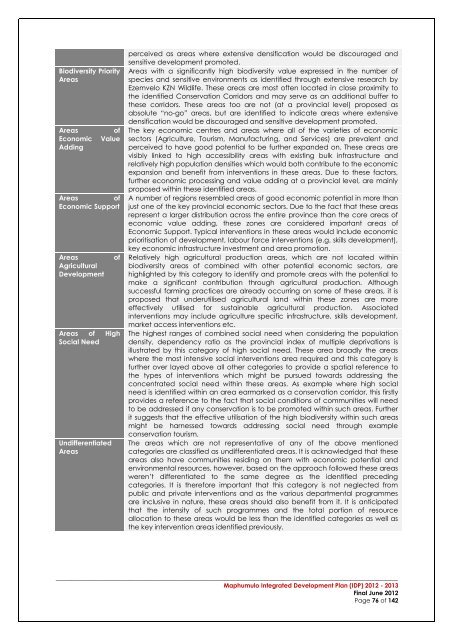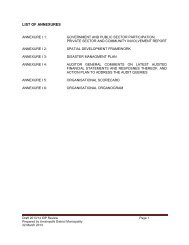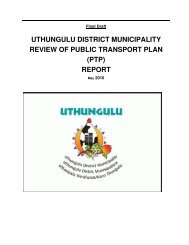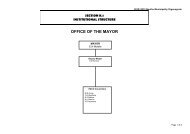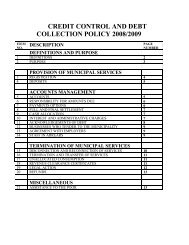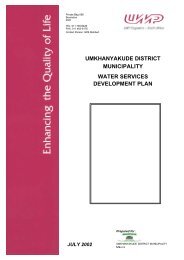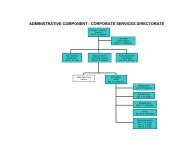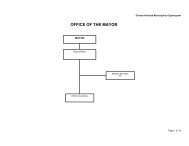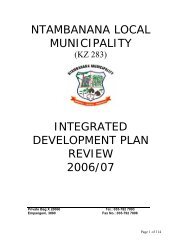The various nodes and their broad intended function and possible interventions aredescribed by the table below.Table 16: The Various Nodes & Their Intended FunctionIntervention Broad Intended FunctionNodePrimary Only eThekwini is classified as a Primary Node within the Provincial Context as an urbanNode centre with very high existing economic growth and the potential for expansionthereof. Provides service to the national and provincial economy.SecondaryNodesRichards Bay, Msunduzi, Newcastle and Port Shepstone has been identified asprovincial Secondary Nodes and thus urban centres with good existing economicdevelopment and the potential for growth and services to the regional economy.TertiaryNodesQuaternaryNodesRural ServiceCentresThese nodes are mainly centres which should provide service to the sub-regionaleconomy and community needs and is represented by the following towns such asPongola,Vryheid,Ulundi,Dundee,Ladysmith,Estcourt,Howick,KwaDukuza,Ixopo,Scottburgh,Hibberdene ,Kokstad, Margate.These nodes are mainly centres which should provide service to the local economyand community needs and is represented by 31 towns, such as but not limited to: PortEdward Nongoma, Nkandla, Bergville, Greytown, Underberg, uMzimkhulu, etc.The proposed rural service centres are envisaged to serves as the lowest level ofprovincial nodes and could typically be established around existing traditionaladministration centres as well as other accessible rural points identified as periodicmarkets. These will be identified in consultation with the district municipalities andshould serve as first access to basic services within rural areas. These rural servicecentres will include, as some have already emerged to include, a combination of thefollowing activities: Traditional administration centre, Taxi/ bus stop, Informal trading / market area, Social facility (clinic, library etc.), Skills development centre (mainly local schools), Mobile services point (mobile clinics, pension pay points, mobile library etc.) Small commercial facility Recreational facility such as a sport field.A conceptual model of these rural service centres will guide the formulation of aprovincial implementation strategy towards the implementation of the proposed RuralService Centres.The Broad Provincial Spatial <strong>Planning</strong> Categories (BPSPCs) which are indicated within theabove illustrated provincial spatial development framework should be interpreted as follows:Table 17: <strong>KZN</strong> Spatial <strong>Development</strong> Plan – Interpretation NotesSpatial <strong>Planning</strong> Broad Intended Land Use and InterventionsCategoryConservation Proposed regional critical conservation areas which are linked in a continuousCorridorssystem of ecosystems and bioregions traversing the province between theDrakensberg and the Indian Ocean. These areas were identified combiningexisting environmentally protected areas as well as conservation corridorsproposed by Ezemvelo <strong>KZN</strong> Wildlife, through combining extensive environmentalresearch into bio-resources throughout the province as part of the formulation ofa Critical Biodiversity Plan for the province. These Conservation Corridors are notsuggested as absolute “no-go” areas, but rather highlighted as areas ofenvironmental significance to the sustainable development of the entireprovince. Where economic opportunity (such as tourism development) and highsocial need exist within these Conservation Corridors, it implies both that the richnatural environment should contribute to the address such needs and potential,and further that any interventions in these areas need to consider the impact onsuch important regional ecological corridors. These corridors are however__________________________________________________________________________________________<strong>Maphumulo</strong> Integrated <strong>Development</strong> Plan (<strong>IDP</strong>) 2012 - 2013Final June 2012Page 75 of 142
Biodiversity PriorityAreasAreasEconomicAddingofValueAreasofEconomic SupportAreasAgricultural<strong>Development</strong>ofAreas of HighSocial NeedUndifferentiatedAreasperceived as areas where extensive densification would be discouraged andsensitive development promoted.Areas with a significantly high biodiversity value expressed in the number ofspecies and sensitive environments as identified through extensive research byEzemvelo <strong>KZN</strong> Wildlife. These areas are most often located in close proximity tothe identified Conservation Corridors and may serve as an additional buffer tothese corridors. These areas too are not (at a provincial level) proposed asabsolute “no-go” areas, but are identified to indicate areas where extensivedensification would be discouraged and sensitive development promoted.The key economic centres and areas where all of the varieties of economicsectors (Agriculture, Tourism, Manufacturing, and Services) are prevalent andperceived to have good potential to be further expanded on. These areas arevisibly linked to high accessibility areas with existing bulk infrastructure andrelatively high population densities which would both contribute to the economicexpansion and benefit from interventions in these areas. Due to these factors,further economic processing and value adding at a provincial level, are mainlyproposed within these identified areas.A number of regions resembled areas of good economic potential in more thanjust one of the key provincial economic sectors. Due to the fact that these areasrepresent a larger distribution across the entire province than the core areas ofeconomic value adding, these zones are considered important areas ofEconomic Support. Typical interventions in these areas would include economicprioritisation of development, labour force interventions (e.g. skills development),key economic infrastructure investment and area promotion.Relatively high agricultural production areas, which are not located withinbiodiversity areas of combined with other potential economic sectors, arehighlighted by this category to identify and promote areas with the potential tomake a significant contribution through agricultural production. Althoughsuccessful farming practices are already occurring on some of these areas, it isproposed that underutilised agricultural land within these zones are moreeffectively utilised for sustainable agricultural production. Associatedinterventions may include agriculture specific infrastructure, skills development,market access interventions etc.The highest ranges of combined social need when considering the populationdensity, dependency ratio as the provincial index of multiple deprivations isillustrated by this category of high social need. These area broadly the areaswhere the most intensive social interventions area required and this category isfurther over layed above all other categories to provide a spatial reference tothe types of interventions which might be pursued towards addressing theconcentrated social need within these areas. As example where high socialneed is identified within an area earmarked as a conservation corridor, this firstlyprovides a reference to the fact that social conditions of communities will needto be addressed if any conservation is to be promoted within such areas. Furtherit suggests that the effective utilisation of the high biodiversity within such areasmight be harnessed towards addressing social need through exampleconservation tourism.The areas which are not representative of any of the above mentionedcategories are classified as undifferentiated areas. It is acknowledged that theseareas also have communities residing on them with economic potential andenvironmental resources, however, based on the approach followed these areasweren’t differentiated to the same degree as the identified precedingcategories. It is therefore important that this category is not neglected frompublic and private interventions and as the various departmental programmesare inclusive in nature, these areas should also benefit from it. It is anticipatedthat the intensity of such programmes and the total portion of resourceallocation to these areas would be less than the identified categories as well asthe key intervention areas identified previously.__________________________________________________________________________________________<strong>Maphumulo</strong> Integrated <strong>Development</strong> Plan (<strong>IDP</strong>) 2012 - 2013Final June 2012Page 76 of 142
- Page 1:
Maphumulo Local MunicipalityMaphumu
- Page 5 and 6:
4.2.2.2 The New Growth Path Focus .
- Page 7 and 8:
6.6.4 THE PLAN ....................
- Page 9 and 10:
Figure 9: Infrastructure, Community
- Page 11 and 12:
FOREWORD BY HER WORSHIP, THE MAYOR
- Page 13 and 14:
1. Municipal Transformation and Ins
- Page 15 and 16:
the local economy and the search fo
- Page 17 and 18:
1.7 MUNICIPAL TURN AROUND STRATEGY
- Page 19 and 20:
infrastructure limits social inclus
- Page 21:
2.2 PROFILE OF THE MAPHUMULO MUNICI
- Page 24 and 25:
2.2.2.3 Sectoral ContributionPublic
- Page 26 and 27: 2.2.2.6 Poverty Stricken AreasThe e
- Page 28 and 29: Mandeni does not have a hospital th
- Page 30 and 31: CrimeCategoryApril2003-March2004Apr
- Page 32 and 33: 2.2.7 DISASTER MANAGEMENTILembe Dis
- Page 34 and 35: MAP 5: Maphumulo GeologyGneiss foun
- Page 36 and 37: agriculture. The Tugela River valle
- Page 38 and 39: MAP 13: Maphumulo Land SensitivityT
- Page 40 and 41: The Slope of Maphumulo indicates th
- Page 42 and 43: 17. The Department of Environmental
- Page 44 and 45: Eco-School ProgrammeWithin IDM, DAE
- Page 46 and 47: 11 1,812 1,812 59 1,753 59 97%Total
- Page 48 and 49: Funding for stage2 approved.KwaHlon
- Page 50 and 51: 2.6.3 ORGANISATIONAL STRUCTUREThe r
- Page 52 and 53: Figure 10: Budget and Treasury Depa
- Page 54 and 55: 2.6.6 COMMUNITY DEVELOPMENT WORKER
- Page 56 and 57: strategic session include; the purp
- Page 58 and 59: HousingEconomicDevelopmentandWater
- Page 60 and 61: OPPORTUNITIESOpportunity to effecti
- Page 62 and 63: Energy Usage- environmental changeA
- Page 64 and 65: 3.1.4 MAPHUMULO VISIONThe municipal
- Page 66 and 67: 4 CHAPTER 4 - THE SPATIAL DEVELOPME
- Page 68 and 69: 4.2.2 THE NEW GROWTH PATH4.2.2.1 In
- Page 70 and 71: 4.2.3 PROVINCIAL SPATIAL ECONOMIC D
- Page 72 and 73: 4.2.4 THE PROVINCIAL GROWTH AND DEV
- Page 74 and 75: Capitalise on complementarities and
- Page 78 and 79: MAP 18: Provincial Spatial Developm
- Page 80 and 81: MaphumuloMunicipalityMAP 20: KZN Sp
- Page 82 and 83: inputs and thus the investment requ
- Page 84 and 85: Settlement in Maphumulo Municipalit
- Page 86 and 87: Introduction and application of the
- Page 88 and 89: 4.11.1 PRIMARY CORRIDORSThe primary
- Page 90 and 91: They are to be used to manage, dire
- Page 92 and 93: Protection and enhancement of the n
- Page 94 and 95: 7.3 DEPARTMENT OF EDUCATIONThe visi
- Page 96 and 97: 7.5 DEPARTMENT OF COPERATIVR GOVERN
- Page 98 and 99: 7.8 THE DEPARTMENT SOCIAL DEVELOPME
- Page 100 and 101: 7.11 DEPARTMENT SPORT &RECREATION7.
- Page 102 and 103: MaphumuloOtimati old clinicconversi
- Page 104 and 105: Joel Jp 3 Constructi 10,277,520onKw
- Page 106 and 107: Cemeteries:StudyDevelopmentPlannedS
- Page 108 and 109: development, infrastructure and inc
- Page 110 and 111: 6.2.5 THE PLANThe plan aims to ensu
- Page 112 and 113: Refer to KPA Schedule and Performan
- Page 114 and 115: • Task 1: Development of a transp
- Page 116 and 117: * The figures are subject to change
- Page 118 and 119: 6.6 FINANCIAL VIABILITY AND MANAGEM
- Page 120 and 121: 7 CHAPTER 7 - FINANCIAL MANAGEMENT7
- Page 122 and 123: Below is a summary of expenditure a
- Page 124 and 125: Figure 20: Maphumulo Capital Budget
- Page 126 and 127:
Ensuring that growth in services is
- Page 128 and 129:
8.4 MAPHUMULO PERFORMANCE MANAGEMEN
- Page 130 and 131:
Figure 23: IDP / Budget / PMS LinkI
- Page 132 and 133:
9 CHAPTER 9 - IMPLEMENTATION PLAN9.
- Page 134 and 135:
Continued and effective participati
- Page 136 and 137:
The results of policy decisions bec
- Page 138 and 139:
Annexure A:Spatial Development Fram
- Page 140 and 141:
12 APPENDICES______________________
- Page 143 and 144:
Maphumulo Local MunicipalityCapital
- Page 145 and 146:
Maphumulo Local MunicipalityCapital
- Page 147 and 148:
Maphumulo Local MunicipalityCapital
- Page 149:
Appendix 2:Service Delivery Budget


